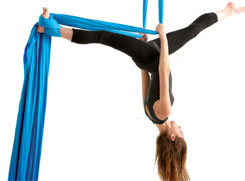 Apart from a strong and toned body, aerial silks also gives you a chance to try out something that is new and different
Apart from a strong and toned body, aerial silks also gives you a chance to try out something that is new and different
Until sometime ago, we saw aerial acts only in circuses or maybe high-end musicals. Now aerial silk performances have become fairly common in dance shows and competitions on stage.
It’s not just about the beauty and aesthetics of it, however. Aerial silk workouts have also gained popularity and attention for its health benefits. While it seems unusual, looks mystic and challenging, it also gives you an exhilarating experience of flying in the air. This workout also requires us to use muscles that we seldom move in other workouts. For instance, women usually do not focus on upper-body workouts and shy away from push-ups and heavy bench-press. Aerial silk, however, requires good strength of upper body and core. The result: a strong and toned body.
Also known as aerial fabric, aerial tissue, aerial ribbon, aerial curtain, aerial rope, aerial sling, and aerial net, this is an incredibly demanding art form that requires a high degree of strength, power, flexibility, courage, and grace to master. Aerial silk artists climb, twist, spin, drop, and contort themselves on fabric curtain sheets that hang from the ceiling.
The beauty of the silky material wrapping around the aerialists body is matched only by the breathtaking courage it takes to be suspended several feet above the ground.
Aerial work is a highly intense fitness programme. So expect to be sore after class, which could last twothree days, and typically occurs in the fingers, forearms, back, and abs. If it lasts longer than five days, consider taking a break until completely healed. Even if new students are in good shape, as with any new movement practice, they will probably still experience soreness.
Aerial work is a unique fitness programme because it introduces the body to the instability of suspension. The body must strengthen all the tiny stabiliser muscles that don’t usually get used. Expect to experience soreness regularly after class for about four to six weeks. Calluses are also normal on palms and fingers.
Aerial silk workout might appear daunting initially, but a good trainer can make you progress easily and gradually. You do not start climbing from day one. There are excellent exercises to initiate you on silk and help you develop skills and strength.
You don’t need any experience to be able to give aerial silks a go. There are tricks and exercises for people of all levels and teachers structure each session so that you can progress.
Aerial silks works pretty much every muscle in the body. Your arms — wrists, forearms, biceps, triceps and shoulders, all get a workout — legs, quads, adductors and abductors, calves and ankles. Aerial silks is also an amazing workout for your back and your abdominals and it strengthens your core as you work.
It is worth mentioning here that the technology to create synthetic fabrics strong enough to hold the incredible amounts of weight of high impact drops has only been around for less than 50 years. Aerial arts are a potentially dangerous activity involving acrobatic work at various heights. The most common injuries are those from overuse of shoulders and back, pulled muscles, bruises, fabric-burns, and dizziness/ nausea (from upside-down or spinning). Possible risks include, but are not limited to, sprains, broken bones, paralysis or even death. Students agree to participate at their own risk.
Thus, it is crucial students take classes only from professional aerial trainers. Aerial arts involve complex wraps and positions, that if executed incorrectly or slightly off could have major consequences including falling out of the air. Do not try to learn from YouTube or people who are not qualified professionals. Unsafe aerial instruction can result in paralysis or death.
